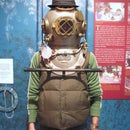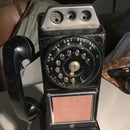Introduction: Etch a Circuit Board With Kitchen Supplies
As you tinker with electronics projects, you'll quickly realize that the more complex they are, the more difficult they are to solder together. It usually means creating a rat's nest of individual wires, which can be bulky and hard to troubleshoot. Time to try making your own circuit boards at home! They're a great way to test new circuit designs, and make assembling your project a lot simpler later on—just add parts.
There's a catch, though: most of the existing kits out there use really nasty chemicals like ferric chloride or hydrochloric acid to etch the copper... so In this instructable, I'll show you a way to do it with stuff in your kitchen. Call it high-tech-low-tech circuit making, if you will..
You'll need:
- 1 copy of Autodesk Eagle (or another board design software)
- 1 package copper clad board (single-sided blank PCB)
- 1 package sticker paper (important: sure backing comes off in ONE BIG PIECE - no premade cuts)
- 1 clothes iron
- 1 office laser printer
- 1 bottle Acetone or nail polish
- 1 bottle of white vinegar
- 1 bottle hydrogen peroxide
- 1 box cooking salt (finely ground is best)
- 1 box Aluminum foil
- Gloves and eye protection
Step 1: Prepare Your PCB Design
Once you've tested your circuit on a breadboard, you can start to lay out your components in software. There are lots of ways to do it - I used Autodesk Eagle, which is free, but very powerful. I won't explain how to use it here—that's way outside the scope of one Instructable. If you want to learn, though, Sparkfun.com has some really great tutorials.
No matter what software you choose, you'll need to save or export the design as a PNG file in order to etch at home. (If you used Eagle, I wrote a quick how-to below).
When you're done, use image editing software like Gimp (or even iPhoto) to flip it and make a MIRROR IMAGE. If you don't, your final PCB will come out backwards.
Getting a board image out of Eagle:
- Click on the "layer settings" button. (looks like three multicolor squares).
- Make sure that ONLY the traces and pads on bottom of the board are displayed. This is the stuff that you want to physically see etched on your board. Usually this will be layer 16 ("Bottom"), 17 ("Pads"), 18 ("Vias"), and 20 ("Dimension)".
- Under the "file" menu, select "export", then "image".
- Set resolution to 1200 dpi, and BE SURE to select "monochrome."
- Give the file a name and save it.
Step 2: Prepare the Transfer Paper
Time to transfer your design to the copper PCB. To do this. you'll need to print it onto the sticker backing paper.
Why? By laser printing the design onto this non-stick paper, we'll be able to easily iron the toner onto the blank copper. Once it's stuck on, it forms a really nice mask—whatever copper is left exposed will be etched away; whatever is covered by printer toner will remain solid metal, forming your circuit.
First, prep the paper. Peel off all the stickers, and wipe the waxy side of the backing with some acetone. Be sure to let it dry. This will remove any oils from your fingers (or the stickers) and give you much more uniform results when you try print onto it.
Step 3: Print Your Transfer
Once the paper is ready, slide it into the "single sheet" tray of your laser printer (usually the one that folds down to accept things like envelopes). Make sure you're printing on the shiny, waxy side!!
If all goes well, you should have a print like the one shown above. If not, no worries - just wipe it off with acetone and try it again! You can usually get 2-3 uses out of a sheet before it starts getting too fragile to use.
Step 4: Transfer Design to PCB
Got a good print? Awesome. Now prep your blank copper board for the transfer.
- Wipe it with acetone and let it dry. DO NOT touch the surface again before the next step! Oil from your fingers will prevent the design from sticking to the copper.
- Attach the blank copper board face-up on a piece of cardboard or scrap wood. Some double-sided tape is helpful to keep it from moving.
- Lay your newly-printed PCB design over the copper board. You can tape the edges in place to keep the sheet from sliding around.
- Set an iron to high (Linen setting), and press down on the sticker paper covering the copper plate. Hold the iron in place, covering the whole board. NOTE: if your edges are coming out jagged or look runny, it means the toner is melting too much. Try putting the iron on a lower setting and just pressing for longer.
- Press hard for 60 seconds, then slowly move the iron while pressing for 3-4 minutes. I found it helpful to press gently on detailed areas with the tip of the iron to make sure they fully transfer.
- Remove heat and wait for board to cool a few minutes. While still warm (but not hot), gently peel off the transfer paper. If you did it right, your design will be stuck to the copper!
- Use a sharpie or nail polish to fill in any areas that didn't fully transfer, or came out faintly. If any traces are too close together, you can also scrape away some of the toner with an X-acto blade or needle.
Step 5: Etch Your Board!
The moment of truth. Put on your gloves and eye protection, and get ready to etch! Before you do though, a word of caution:
DO NOT, I repeat, DO NOT pour any acetone into the etching solution. Acetone and hydrogen peroxide can react to cause a highly flammable and possibly explosive chemical.Given the low concentrations of hydrogen peroxide we're using (3% solution), that's unlikely, you're still better safe than sorry. Now on with the show!
- Mix together a 1:1 ratio of vinegar and peroxide in a small tupperware container. I found it helpful to heat it in the microwave to speed up the chemical reaction.
- Add as much salt as the solution will hold.
- Lay the PCB with your newly-transferred design in the bin. You should hear a fizzing sound as the reaction starts to work.
- Occasionally stir the mixture, and add more salt and peroxide as needed. Some crud will form on the surface of the copper board as it dissolves - you can speed the process by wiping it off gently with a sponge or brush.
- After about an hour or so, your board should be done! Be sure to RINSE THE BOARD WITH WATER, then wipe the remaining toner off with acetone and let it dry.
- Next, drill holes in the component pads with tiny bits like these (a drill press or a steady hand helps - they break really easily).
You're almost ready to start soldering! The last thing to do (and this is important), is safely clean up your mess.
Step 6: Safely Dispose of the Etchant
When you're done etching, the liquid will look blue-green. That's because the process created copper (II) acetate, which is poisonous. It's not awesome to flush it down the drain, so we're going to neutralize it.
- Cut up about a square foot of aluminum foil into small pieces. Stir the pieces into the blue-green etch liquid, and leave outside for a few hours.
- The liquid will turn purple, and you'll see little brown specks settling to the bottom. Congrats: you just turned that copper chloride into harmless aluminum salts and elemental copper (the brown specks).
- Now you can dispose of it safely in your drain.
Final notes: Don't be discouraged if your board doesn't come out right the first time. It took a bit of trial and error to get mine the way I wanted them - but it's way faster and more satisfying than ordering boards from overseas!
Also: I am NOT a chemist - if you are, please weigh in on the disposal methods! For more info on this etching technique (and on disposal), there's a great discussion at Blondihacks.com. Happy building!
******
UPDATE: a few folks pointed out in the comments that my chemistry might be slightly off - with enough salt in the mix, the solution could turn green, meaning it's copper (II) chloride—the same stuff in some root killers. In that case, adding aluminum foil would just make another poisonous chemical, aluminum (II) chloride, and shouldn't be put down the drain. See discussion on stackexchange for more details.
if there's any doubt on whether or not it's safe to flush the liquid, though, you can always mix it with plaster of paris, wait for it to harden, and throw the whole thing away.




